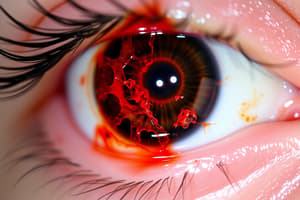Podcast
Questions and Answers
What is a primary reason alkali burns have a worse prognosis than acidic burns?
What is a primary reason alkali burns have a worse prognosis than acidic burns?
- Acids penetrate the skin more quickly.
- Alkali raises tissue pH, increasing cell membrane breakdown. (correct)
- Alkali burns occur less frequently.
- Alkali burns cause less pain.
Which of the following is a common agent that can cause acidic burns?
Which of the following is a common agent that can cause acidic burns?
- Calcium carbonate
- Magnesium hydroxide
- Sodium hydroxide
- Hydrofluoric acid (correct)
In which setting do the majority of chemical ocular burns occur?
In which setting do the majority of chemical ocular burns occur?
- Industrial workplaces (correct)
- Outdoor recreational areas
- Laboratories
- Home kitchens
Which symptom is NOT associated with chemical burns?
Which symptom is NOT associated with chemical burns?
What can severe chemical burns cause in terms of intraocular pressure (IOP)?
What can severe chemical burns cause in terms of intraocular pressure (IOP)?
What does scleral and limbal blanching indicate in the context of severe chemical burns?
What does scleral and limbal blanching indicate in the context of severe chemical burns?
How much faster can alkali agents penetrate the eye compared to acidic agents?
How much faster can alkali agents penetrate the eye compared to acidic agents?
Which of the following is NOT classified as a common alkali agent?
Which of the following is NOT classified as a common alkali agent?
Flashcards are hidden until you start studying
Study Notes
Chemical Burn
- Recent exposure to chemical or thermal agents is a primary cause of chemical burns, particularly in industrial settings, which account for approximately 66% of ocular burns.
- Symptoms include normal or decreased vision, pain, foreign body sensation, photophobia, tearing, and blepharospasm.
- Signs of chemical burns in the cornea can vary from mild superficial punctate keratitis (SPK) to complete epithelial sloughing in severe cases.
- Additional signs encompass conjunctival injection, chemosis, ciliary injection, anterior chamber reaction, conjunctival hemorrhages, and blanching of the sclera and limbus, indicative of ischemia in severe burns, with potential increases in intraocular pressure (IOP).
- Alkali burns present a worse prognosis than acidic burns due to their ability to raise tissue pH, leading to rapid penetration and cellular damage within one minute.
- Alkali burns are more prevalent than acidic burns, largely due to the accessibility of alkali agents to consumers.
- Common alkali agents include:
- Ammonia: found in fertilizers and cleaning products
- Lye: found in drain cleaners
- Magnesium hydroxide: associated with flares and fireworks
- Lime: found in plaster, mortar, cement, whitewash, and mouthwash
- Airbag residue
- Common acidic agents include:
- Hydrofluoric acid: used in glass polishing and rust removal
- Sulfuric acid: found in fertilizers, explosives, dyes, and battery acid
- Nitric acid: used in fertilizers, explosives, and as a rocket propellant
- Chromic acid: used for wood preservation
- PAVA spray: a variant of pepper spray containing pelargonic acid.
Studying That Suits You
Use AI to generate personalized quizzes and flashcards to suit your learning preferences.




